
The Solar-Terrestrial Centre of Excellence (STCE) is a collaborative network of the Belgian Institute for Space Aeronomy, the Royal Observatory of Belgium and the Royal Meteorological Institute of Belgium.
 |
Published by the STCE - this issue : 23 Jan 2015. The Solar-Terrestrial Centre of Excellence (STCE) is a collaborative network of the Belgian Institute for Space Aeronomy, the Royal Observatory of Belgium and the Royal Meteorological Institute of Belgium. |
| Archive of the newsletters | Subscribe to this newsletter by mail |
During the morning hours of 13 January, a rather strong M-class flare took place in active region NOAA 2257, close to the northwest limb. This sunspot group seemed deceptively simple, but harbored some opposite magnetic polarity spots close to each other. That's a configuration that often results in a flare.

Closer examination of the GOES x-ray curve (image above) revealed that the event actually consisted of 2 M-class flares separated by only 34 minutes: An M5.6 flare peaking at 04:24UT, and an M4.9 flare peaking at 04:58UT. They both took place in the same region. Obviously, such closely time-separated M-class flares do not happen very often, but they are by no means exceptional. For example, on 22 December 2013, there were only 26 minutes between two M1 flares in NOAA 1928. And, though rare, this occasionally happens with X-class flares too, such as the X1-X6 flares on 18 August 1979 whose peaks were also separated by only 26 minutes.
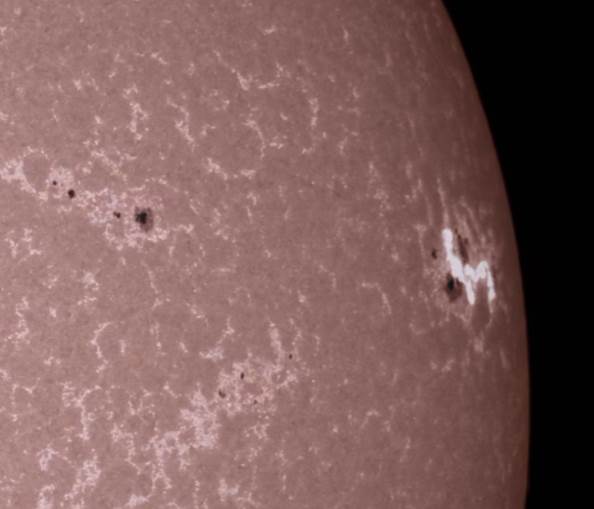
The image above combines a white light image with an SDO/AIA1700 image of the Sun's lower atmosphere. Taken at 04:22UT, it shows the location of the flare ribbons relative to the sunspots. The flare seems to have been confined, i.e. no obvious coronal mass ejection seems to have been associated with this flare.
A compact series of bright post-flare coronal loops ("arcade") quickly developed after the M-class event. The movie at http://youtu.be/d2MuNgr3IgM shows the loops in successively hotter temperatures as seen in SDO's filters AIA 304 (about 80.000 degrees), AIA 171 (about 700.000 degrees), and AIA 131 (several million degrees). The images underneath show the loops around 07:04UT in the three filters.

Starting after 12:00UT, some recurring jets (see images underneath) can be seen emanating from the leading portion of NOAA 2257. The jets consist of rather cold plasma (best seen in the "colder" AIA304 filter), recur about every hour, but at decreasing height and intensity. In previous, similar events, these features were thought to have their origin in a reconnection of the restructuring magnetic fields in the Sun's lower atmosphere. With NOAA 2257 so close to the solar limb, confirmation and further details require some more extensive investigation. None of these jets were associated with CMEs.
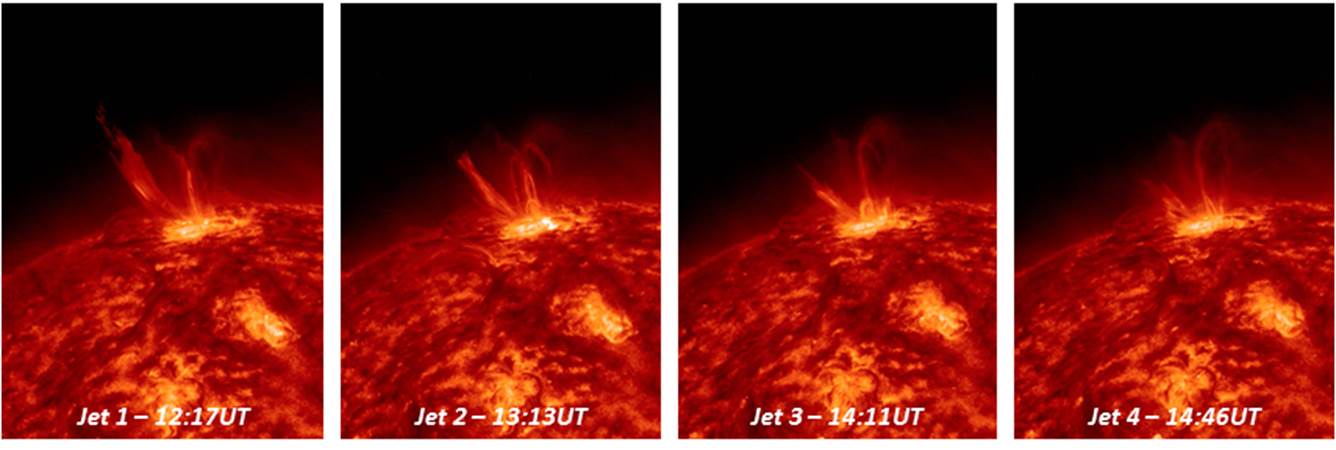
Credits: Images taken from STAFF (http://www.staff.oma.be/), SDO (http://sdo.gsfc.nasa.gov/), PROBA2 (http://proba2.oma.be/ssa), and Helioviewer (http://helioviewer.org/).
SOLAR/SOLSPEC is an absolute calibrated spectroradiometer measuring the Solar Spectral Irradiance (SSI) from space and is part of the SOLAR payload of the Columbus module on board of the International Space Station (ISS). The SOLAR mission is ongoing since 2008.
The consortium organises a workshop 'Six years of SOLAR/SOLSPEC mission on ISS, Achievements and Prospects' from March 10 to 12, 2015.
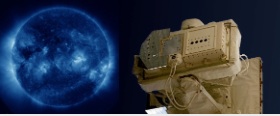
Topics:
* The SOLAR/SOLSPEC design typical for a long-term mission, the pre-flight radiometric characterization and absolute calibration and the in-flight performances since 2008.
* Comparison with other instruments and models of the UV, VIS and IR science data.
* Time-resolved SSI data in Chemistry-Climate Models.
* A strategy for the next years and how to handle the demands from the science community: SOLAR/SOLSPEC – SORCE comparisons, stratospheric ozone modelling, delivery of reference spectra.
Check
http://www.stce.be/solspecworkshop2015/
Solar activity at the beginning of the week was dominated by NOAA AR 2257 (beta-gamma-delta magnetic configuration) that produced three M-class flares: M5.6 at 04:24 UT, M4.9 at 04:58 UT on January 13 and M2.2 at 12:58 UT on January 14. None of these flares were related to CMEs.
Only minor C-class flares occurred after January 15.
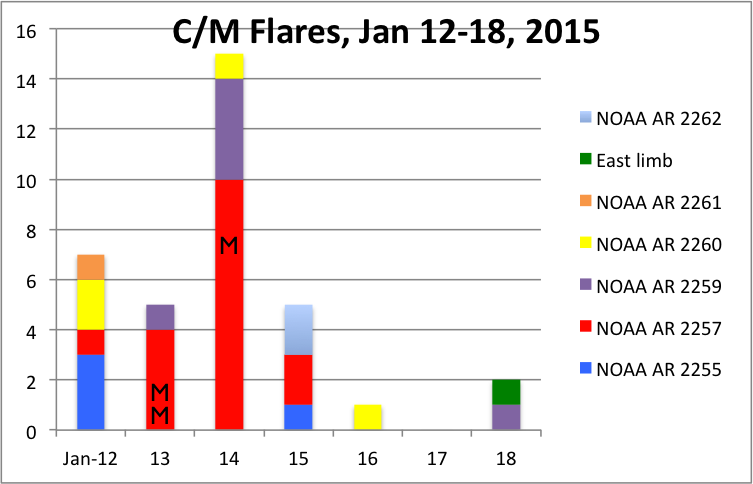
A partial halo CME originating from NOAA AR 2261 came into the Field of View of LASCO-C2 at 15:36 UT on January 12. It was a faint CME with speed around 1000 km/s with an Earth directed component, but finally did not arrive to the Earth.
Geomagnetic conditions ranged from quiet to unsettled the whole week.
| DAY | BEGIN | MAX | END | LOC | XRAY | OP | 10CM | TYPE | Cat | NOAA |
| 13 | 0413 | 0424 | 0438 | N6W70 | M5.6 | 2B | 290 | III/1 | 50 | 2257 |
| 13 | 0446 | 0458 | 0510 | M4.9 | VI/2 | 50 | 2257 | |||
| 14 | 1230 | 1258 | 1308 | M2.2 | III/1 | 50 | 2257 |
| LOC: approximate heliographic location | TYPE: radio burst type |
| XRAY: X-ray flare class | Cat: Catania sunspot group number |
| OP: optical flare class | NOAA: NOAA active region number |
| 10CM: peak 10 cm radio flux |
Solar flare activity fluctuated between quiet and moderate during the week.
In order to view the activity of this week in more detail, we suggest to go to the following website from which all the daily (normal and difference) movies can be accessed: http://proba2.oma.be/ssa
This page also lists the recorded flaring events.
A weekly overview movie can be found here (SWAP week 251).
http://proba2.oma.be/swap/data/mpg/movies/weekly_movies/weekly_movie_2015_01_12.mp4
Below we provide SWAP images of the time when a strong Mflare occurred on 2015Jan13.
M4.9 flare peaking around 04h58
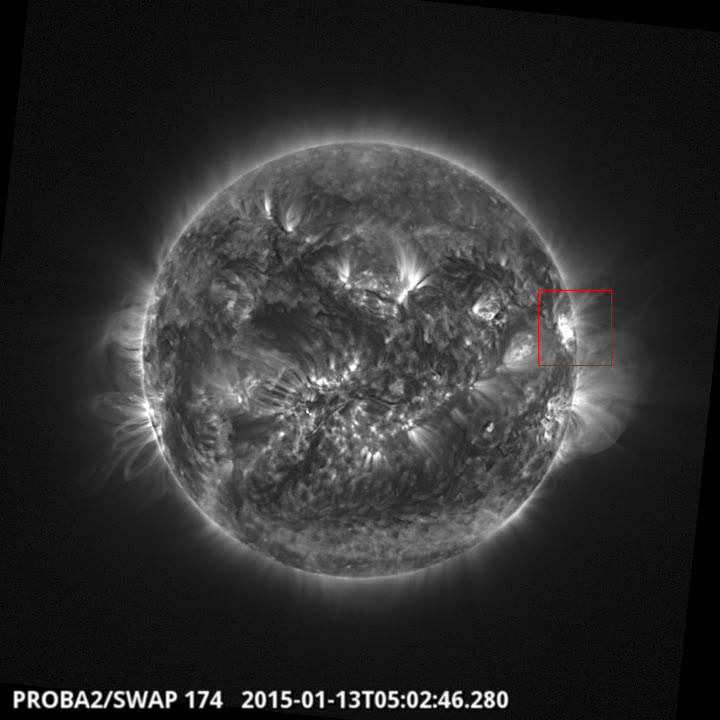
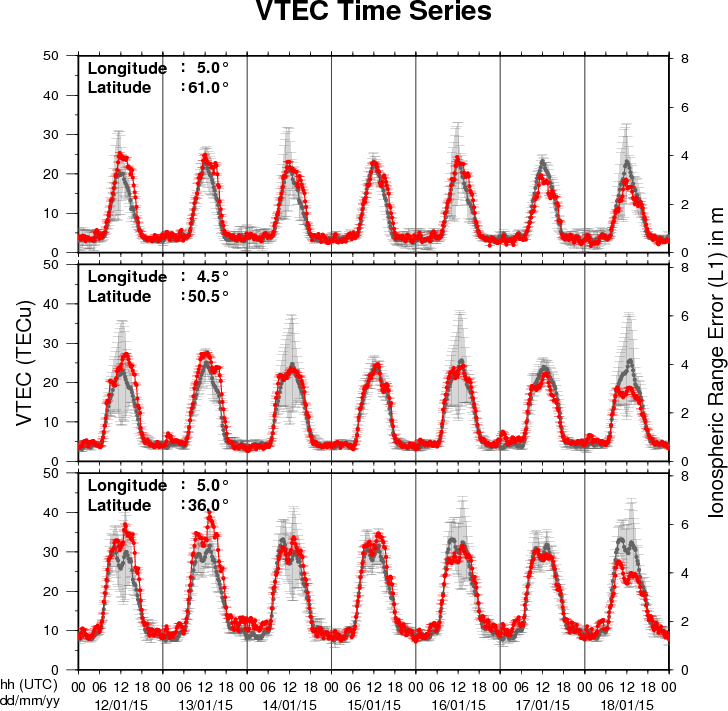
The figure shows the time evolution of the Vertical Total Electron Content (VTEC) (in red) during the last week at three locations:
a) in the northern part of Europe(N61°, 5°E)
b) above Brussels(N50.5°, 4.5°E)
c) in the southern part of Europe(N36°, 5°E)
This figure also shows (in grey) the normal ionospheric behaviour expected based on the median VTEC from the 15 previous days.
The VTEC is expressed in TECu (with TECu=10^16 electrons per square meter) and is directly related to the signal propagation delay due to the ionosphere (in figure: delay on GPS L1 frequency).
The Sun's radiation ionizes the Earth's upper atmosphere, the ionosphere, located from about 60km to 1000km above the Earth's surface.The ionization process in the ionosphere produces ions and free electrons. These electrons perturb the propagation of the GNSS (Global Navigation Satellite System) signals by inducing a so-called ionospheric delay.
See http://stce.be/newsletter/GNSS_final.pdf for some more explanations ; for detailed information, see http://gnss.be/ionosphere_tutorial.php
Start : 2015-03-16 - End : 2015-03-19
This international conference will provide an overview of our
current understanding of Sun-Climate Connections starting at
processes on the Sun itself over space weather and solar wind
towards solar influence on the upper atmosphere down to the ocean.
It will also provide insights into the heatedly debated role of the
Sun in climate change. In four sessions the various contributions
of solar variability influence on Earth's climate will be presented
and discussed by bringing together solar physicists, space
scientists, atmospheric scientists, climate modellers, and
paleoclimatologists.
We expect contributions from scientists participating in
SCOSTEP/ROSMIC, SPARC-SOLARIS/HEPPA, the EU cost network TOSCA, as
well as any other interested scientists. The conference will last
three full days, beginning Monday morning, 16 March 2013. The
programme will consist of invited and keynote lectures, a few
contributed oral presentations and ample time dedicated to poster
sessions. The fourth day will be devoted to public outreach
activities as well as panel discussions.
Website: http://scc.geomar.de/
Start : 2015-05-18 - End : 2015-05-22
URSI AT-RASC 2015 will be the first edition of the newly
established triennial URSI Atlantic Radio Science Conference as one
of the URSI Flagship Conferences. AT-RASC 2015 will have an open
scientific program composed of submitted papers within the domains
covered by all ten Commissions of URSI.
Website: http://www.at-rasc.com/
Start : 2015-06-01 - End : 2015-07-24
The Space Weather Summer School at Los Alamos National
Laboratory, established in 2011 under the founding Director Josef
Koller, is dedicated to space weather, space science and
applications. Every year we solicit applications for the Los Alamos
Space Weather Summer School. This summer school is sponsored and
supported by a number or organizations at LANL. This year our top
sponsors include the Los Alamos Institute of Geophysics, Planetary
Physics and Signatures (IGPPS) and the Laboratory Directed Research
and Development Office (LDRD). The summer school brings together
top space science students with internationally recognized
researchers at LANL in an educational and collaborative
atmosphere.
Website:
http://www.swx-school.lanl.gov/
Start : 2015-07-21 - End : 2015-07-23
The conference will review past and recent achievements, as well
as future challenges in the field of solar coronal loop
physics.
Website:
http://www.damtp.cam.ac.uk/user/astro/cl7/index.html
Start : 2015-07-28 - End : 2015-08-04
Heliophysics is all of the science common to the field of the
Sun-Earth connections. This fast-developing field of research
covers many traditional sub-disciplines of space physics,
astrophysics, and climate studies. The NASA Living with a Star
program, with its focus on the basic science underlying all aspects
of space weather, acts as a catalyst to bring the many research
disciplines together to deepen our understanding of the system of
systems formed by the Sun-Earth connection.
Website:
http://www.heliophysics.ucar.edu/
Start : 2015-07-30 - End : 2015-08-06
The 34th International Cosmic Ray Conference (ICRC) will be held
from July 30 to August 6, 2015, in The Hague, The Netherlands. It
is an important and large conference in the field of Astroparticle
Physics. The ICRC covers: cosmic-ray physics, solar and
heliospheric physics, gamma-ray astronomy, neutrino astronomy, and
dark matter physics.
Website: http://icrc2015.nl
Start : 2015-10-05 - End : 2015-10-09
This CSPM-2015 scientific meeting will cover various aspects of
solar dynamic and magnetic phenomena which are observed over the
entire electromagnetic spectrum: white-light, Hα, Ca II,
and radio from ground and in a variety of other wavelengths (white
light, UV and EUV, and X-rays) from space. Emphasis will also be
placed on instrumentation, observing techniques, and solar image
processing techniques, as well as theory and modelling through
detailed radiative transfer in increasingly realistic MHD models.
The long-term (cyclic) evolution of solar magnetism and its
consequence for the solar atmosphere, eruptive phenomena, solar
irradiation variations, and space weather, will be in focus. Here,
special attention will be devoted to the long-term observations
made in Coimbra and also to the results of the SPRING / SOLARNET
and SCOSTEP VarSITI studies. In particular, the weak solar activity
during the current solar maximum will be discussed. Finally, since
this meeting is organised around the 90th anniversary of performing
the first spectroheliographic observations in Coimbra, a session
will be specially dedicated to new solar instruments (both
ground-based and space-borne) that will give access to unexplored
solar atmospheric features and dynamic phenomena over the coming
years.
Website:
http://www.mat.uc.pt/~cspm2015/
Start : 2016-07-30 - End : 2016-08-07
The 41st COSPAR Scientific Assembly will be held in Istanbul,
Turkey from 30 July - 7 August 2016. This Assembly is open to all
bona fide scientists.
Website:
https://www.cospar-assembly.org/